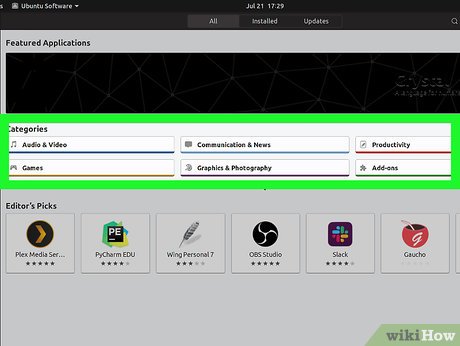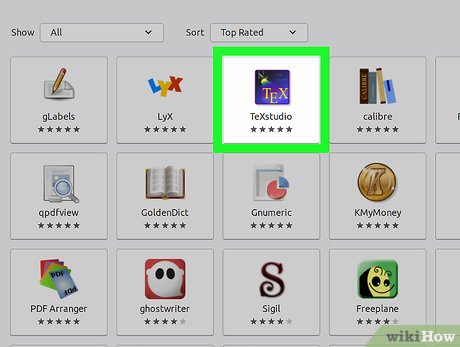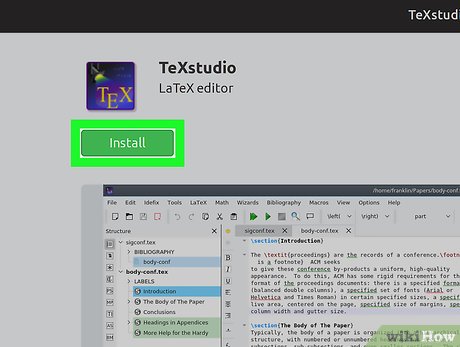How to Install Ubuntu Packages
Method 1 of 3:
Using the Ubuntu Software Center
-
 Open Ubuntu Software Center. You'll find this in your Launcher.
Open Ubuntu Software Center. You'll find this in your Launcher. -
 Search or browse for an application. The search bar is located on the upper right side of the window; the categories for you to browse are on the left, including categories such as Accessories, Books and Magazines, Developer Tools, Education, and Fonts.
Search or browse for an application. The search bar is located on the upper right side of the window; the categories for you to browse are on the left, including categories such as Accessories, Books and Magazines, Developer Tools, Education, and Fonts. -
 Click on the application you want. The line will highlight.
Click on the application you want. The line will highlight. -
 Click Install. You'll see this to the right of the application name. When you click to install, a window will pop up for your login information.
Click Install. You'll see this to the right of the application name. When you click to install, a window will pop up for your login information.- If you don't see the button to install, you might need to allow downloading from different sources from 'Software Sources' in the 'Edit' tab. You'll need to make sure all the boxes are checked.
-
 Type your password and click Authenticate. You'll see a progress bar of the installation progress. You'll find the icon of the installed app in the Launcher.
Type your password and click Authenticate. You'll see a progress bar of the installation progress. You'll find the icon of the installed app in the Launcher.
Method 2 of 3:
Using Synaptic
-
 Open Synaptic. You'll find this on your Launcher, but it isn't a default program like the Ubuntu Software Center and you'll have to install it.
Open Synaptic. You'll find this on your Launcher, but it isn't a default program like the Ubuntu Software Center and you'll have to install it.- To install Synaptic, press Ctrl+Alt+T to open Terminal. Type sudo apt install synaptic and press ↵ Enter. Synaptic will install and you'll see the app icon appear on your Launcher. You can close the Terminal.
-
 Search for an application. You'll find the search bar on the right side of the window.
Search for an application. You'll find the search bar on the right side of the window. -
 Click on the application you want to install. The line will highlight and a box will pop up.
Click on the application you want to install. The line will highlight and a box will pop up. -
 Click Mark for Installation. The box will disappear, but another box will pop up explaining what else needs to be installed in order for the application you want to work.
Click Mark for Installation. The box will disappear, but another box will pop up explaining what else needs to be installed in order for the application you want to work. -
 Click Mark. All the dependencies and required applications will also be marked for installation.
Click Mark. All the dependencies and required applications will also be marked for installation.- You can continue selecting packages to install.
-
 Click Apply. You'll see this in the top toolbar, with a green checkmark. You'll need to confirm this action. Installation might take a while, depending on how many packages you are installing and your internet speed.
Click Apply. You'll see this in the top toolbar, with a green checkmark. You'll need to confirm this action. Installation might take a while, depending on how many packages you are installing and your internet speed.- You can find your installed applications by searching from the Launcher. Some applications may require you to restart your computer before you can use them.
Method 3 of 3:
Using Terminal
-
 Press Ctrl+Alt+T to open Terminal. You can also search for Terminal from the Ubuntu Dash.
Press Ctrl+Alt+T to open Terminal. You can also search for Terminal from the Ubuntu Dash. -
 Type "apt-cache show" to show the details of the app. If you know the app's name correctly, it will appear here. If not, you will get an error message and you might have to browse the categories to find the right name.
Type "apt-cache show" to show the details of the app. If you know the app's name correctly, it will appear here. If not, you will get an error message and you might have to browse the categories to find the right name.- To search categories, type "apt-cache search." For example, to search for a racing game, type: apt-cache search racing game.
-
 Type 'apt-get install' to download an app. To download the package, use 'apt-get install.' For example, the app name is Torcs, so you would type apt-get install torcs.
Type 'apt-get install' to download an app. To download the package, use 'apt-get install.' For example, the app name is Torcs, so you would type apt-get install torcs.- To search your computer to see if you already have that game, use 'apt-cache policy.'[1]
- You can find the icon to the app you just installed from your Dash.
5 ★ | 1 Vote














 How to Set Your Computer to Log on Automatically
How to Set Your Computer to Log on Automatically How to Make a Map Using OpenLayers 3
How to Make a Map Using OpenLayers 3 How to Load an Image Onto a PC Using Ghosting
How to Load an Image Onto a PC Using Ghosting How to Make a Map Using Google Maps JS API
How to Make a Map Using Google Maps JS API How to Use eXe
How to Use eXe How to Sync Files With 4Shared Sync
How to Sync Files With 4Shared Sync